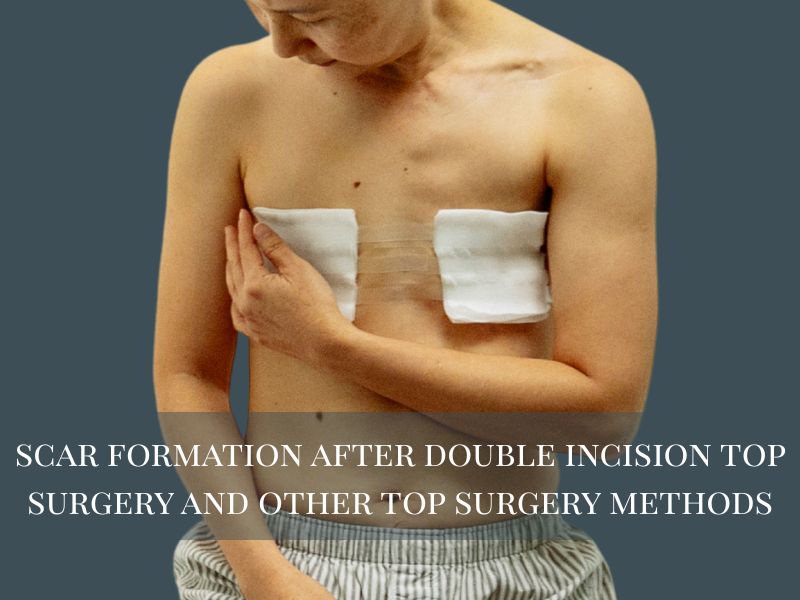Top surgery scars are something most people think about at some point in the healing journey. Some wear them with pride, while others hope they fade; both feelings are valid. These surgery scars can appear differently depending on your body, the surgical method, and the rate of your skin’s healing.
There’s no one-size-fits-all approach. Still, there are ways to support your healing process and help scars settle in more comfortably. Simple things like using scar massage, staying hydrated, or applying silicone scar cream can make a difference. Avoiding sun exposure early on can also help with long-term scar healing.
Overview of FTM Top Surgery
FTM top surgery is performed to create a flat, more masculine chest by removing breast tissue. The approach isn’t always the same. It depends on your chest size, the elasticity of your skin, and whether excess skin needs to be removed during the process.
The most common method is called double incision. It’s usually recommended for people with medium to large chests. The surgeon makes two horizontal surgical incisions across the lower part of the chest and typically performs a nipple graft. This technique offers strong results, but it also leaves behind more noticeable top surgery scars.
For smaller chests, less invasive options like keyhole or peri-areolar surgery might be possible. These use smaller incisions near the areola and tend to leave lighter surgery scars, though they’re only appropriate for people with good skin elasticity and little scar tissue.
Regardless of the method used, the body requires time to heal. Working with a board-certified plastic surgeon who understands the goals of gender-affirming care can make a significant difference in both surgical outcomes and the formation and settling of scars over time.
Scar Formation After Double Incision Top Surgery and Other Top Surgery Methods

After top surgery, your chest undergoes significant changes. Scar tissue starts forming right away. If you had the double incision method, there’s usually more scarring since the cuts are longer. Some people get hypertrophic scars, which are raised but stay along the incision. Others heal flatter. Factors such as your skin tone, genetics, and how your body reacts all influence how the scars develop and settle. The healing process isn’t the same for everyone, and those first few weeks can really shape the long-term appearance of scars.
Hypertrophic Scars
After top surgery, it’s not unusual for the incision lines to raise up a bit. These are called hypertrophic scars. They don’t grow outside the original cut, but they can feel thick, firm, and sometimes itchy. For many people, these scars typically appear during the early healing phase, usually within the first few weeks after surgery, and gradually settle over time.
Some bodies just make more scar tissue than others. If there’s tension on the incision or if healing is slowed down, these scars might be more noticeable. You can help the scar healing process along with regular scar massage, staying on top of your scar care routine, and using things like silicone gel to soften the tissue. Protecting the area from sun exposure also helps prevent discoloration, especially in the first year.
Keloid Scars
Keloids are a little different. They’re raised like hypertrophic scars, but they keep growing beyond the edges of the incision. Some people never get them; others are more prone, especially those with darker skin tones or a history of keloid scarring.
These scars can be uncomfortable. They might feel tight, sore, or itchy. They’re also more resistant to typical treatments, which is why some patients explore steroid injections, laser treatments, or even revision surgery if the scar gets in the way of movement or confidence.
Keloids are tough to predict. That’s why it helps to talk to your plastic surgeon early, especially if you’ve dealt with them before. The goal isn’t perfection; it’s managing what shows up and knowing there are real treatment options if your scar appearance becomes a concern.
Overview of the Healing Process After Revision Surgery
Healing after revision surgery isn’t always the same as healing from your first top surgery. For some, it’s easier. For others, it takes more time. It depends on how your body responded the first time, how much scar tissue has built up, and how much the surgeon needed to change during the second procedure.
Swelling and tightness are common in the first few weeks after surgery, but the way your body reacts might not be the same as it was the first time. Some people feel more sensitive around the incision, while others feel less. The skin has already healed once, so going through another surgery procedure means it may take longer to heal. Even so, the healing process still follows the same steps: first, inflammation, then new tissue builds, and slowly, things start to smooth out.
It’s important to take care of your skin during this time. That includes staying consistent with scar massage, using silicone gel, and keeping the area protected from sun exposure. These small steps support scar healing and help the tissue stay soft and flexible. Over time, many people see their scar appearance improve, though the process can take several months or even a full year to finish.
If you notice firm or raised spots that don’t change, steroid injections might be recommended to flatten them out. Everyone heals differently, and no two revision recoveries look the same. What matters most is listening to your body, giving it time, and following through with your skin care routine.
How Scars Affect People with Darker Skin Tones

If your skin tone is darker, you may notice your scars heal differently. Raised scarring, especially keloid scars happens more often, and the color change can be more noticeable. That’s partly due to how your body produces collagen and how blood vessels form during healing.
You can’t fully control how your body responds, but you can give it the best chance. Start caring for your scars once the incisions are closed. Keep them covered in the sun, use products like silicone sheets, and talk to your healthcare team about options if thick scarring shows up. Some people benefit from medical tattooing or revision down the line, but starting early can help a lot.
Laser Therapy to Reduce Scar Appearance
Laser treatments are often used to improve scar appearance after top surgery, especially when noticeable scars remain raised or discolored as they mature. This option works by targeting the top layers of scar tissue to reduce thickness, smooth texture, and sometimes reduce redness. While it won’t erase visible scars, it can make a noticeable difference in how the appearance of scars blends with the surrounding skin. Results vary depending on skin type, scar age, and how the body heals, so it’s best to speak with your surgical team about whether this is a good fit for you.
How Long Until You’re Fully Healed After Top Surgery?
Healing after top surgery doesn’t happen all at once. Most of the swelling fades within a few weeks after surgery, but the deeper layers take much longer. While you may feel physically recovered in a couple of months, the full wound healing process, both under the skin and across the chest, can take up to a year or more. Some people heal faster than others, but reaching a fully healed state with soft, mature scars depends on your body, your overall health, and how you care for your chest as the healing process unfolds.
FAQs: Top Surgery Scars
Will my top surgery scars ever go away completely?
No. They’ll fade over time, but scars from top surgery don’t disappear completely.
What’s the difference between hypertrophic and keloid scars?
Hypertrophic scars stay within the incision line; keloid-type scars grow beyond it.
Can I do anything to prevent dark or raised scars after surgery?
Yes. Avoid sun exposure, use silicone sheets, and follow a good scar care routine.
How Old Do You Have to Be to Get Top Surgery?
Top surgery is generally available to individuals 18 or older, though some states may allow it earlier with parental consent. Laws vary and are changing, so it’s important to check your state’s current regulations.
Schedule Your Top Surgery Consultation
Thinking about FTM top surgery? Schedule a consultation with Dr. CV Chegireddy at Atlanta Plastic Surgery. We offer expert care from your initial visit through wound healing, with support at every step, from surgery to long-term scar management.



